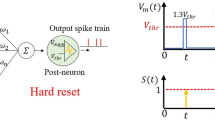Abstract
Mott devices, featuring low hardware cost and high energy efficiency, have been demonstrated as a key oscillatory element in artificial neurons to enable spiking neural networks (SNNs) such as conversion-based SNNs (CSNNs). However, there will be inevitably non-ideal fluctuation in the oscillation behavior, causing the accuracy degradation of networks. In this paper, we investigate the Mott neuronal oscillation fluctuation (NOF) through experiments and modeling. The results show that the NOF phenomenon conforms to Gaussian distribution and originates from thermal fluctuation induced switching voltage variations. We construct a two-layer CSNN for image recognition tasks to study the NOF effect and propose the activation function boundary (AFB) method to strengthen the stability of the network. The results indicate that AFB can improve the accuracy of CSNN by up to 15.5% by tightening output distribution.
Similar content being viewed by others
References
Zhang Z H, Wang Z W, Shi T, et al. Memory materials and devices: from concept to application. InfoMat, 2020, 2: 261–290
Wu L D, Wang Z W, Wang B W, et al. Emulation of biphasic plasticity in retinal electrical synapses for light-adaptive pattern pre-processing. Nanoscale, 2021, 13: 3483–3492
Zhao Y L, Yang J L, Li B, et al. NAND-SPIN-based processing-in-MRAM architecture for convolutional neural network acceleration. Sci China Inf Sci, 2023, 66: 142401
Han Y N, Xiang S Y, Zhang T R, et al. Conversion of a single-layer ANN to photonic SNN for pattern recognition. Sci China Inf Sci, 2024, 67: 112403
Pei J, Deng L, Ma C, et al. Multi-grained system integration for hybrid-paradigm brain-inspired computing. Sci China Inf Sci, 2023, 66: 142403
Roy K, Jaiswal A, Panda P. Towards spike-based machine intelligence with neuromorphic computing. Nature, 2019, 575: 607–617
Sengupta A, Ye Y T, Wang R, et al. Going deeper in spiking neural networks: VGG and residual architectures. Front Neurosci, 2019, 13: 95
Zhang X M, Wang Z R, Song W H, et al. Experimental demonstration of conversion-based SNNs with 1T1R Mott neurons for neuromorphic inference. In: Proceedings of IEEE International Electron Devices Meeting, San Francisco, 2019
Wang Z R, Rao M Y, Han J W, et al. Capacitive neural network with neuro-transistors. Nat Commun, 2018, 9: 3208
Bao L, Kang J, Fang Y C, et al. Artificial shape perception retina network based on tunable memristive neurons. Sci Rep, 2018, 8: 13727
Wu L D, Wang Z W, Bao L, et al. Implementation of neuronal intrinsic plasticity by oscillatory device in spiking neural network. IEEE Trans Electron Dev, 2022, 69: 1830–1834
Fu Y Y, Zhou Y, Huang X, et al. Forming-free and annealing-free V/VOx/HfWOx/Pt device exhibiting reconfigurable threshold and resistive switching with high speed (<30 ns) and high endurance (> 1012/> 1010). In: Proceedings of IEEE International Electron Devices Meeting, San Francisco, 2021
Yan B N, Yang Y C, Huang R. Memristive dynamics enabled neuromorphic computing systems. Sci China Inf Sci, 2023, 66: 200401
Lee D, Kwak M, Moon K, et al. Various threshold switching devices for integrate and fire neuron applications. Adv Elect Mater, 2019, 5: 1800866
Zhang X M, Zhuo Y, Luo Q, et al. An artificial spiking afferent nerve based on Mott memristors for neurorobotics. Nat Commun, 2020, 11: 51
Woo J Y, Wang P N, Yu S M. Integrated crossbar array with resistive synapses and oscillation neurons. IEEE Electron Dev Lett, 2019, 40: 1313–1316
Duan Q X, Jing Z K, Zou X L, et al. Spiking neurons with spatiotemporal dynamics and gain modulation for monolithically integrated memristive neural networks. Nat Commun, 2020, 11: 3399
Zhang X M, Wu Z, Lu J K, et al. Fully memristive SNNs with temporal coding for fast and low-power edge computing. In: Proceedings of IEEE International Electron Devices Meeting, San Francisco, 2021
Kim G M, In J H, Kim Y S, et al. Self-clocking fast and variation tolerant true random number generator based on a stochastic Mott memristor. Nat Commun, 2021, 12: 2906
Wang Z W, Zheng Q L, Kang J, et al. Self-activation neural network based on self-selective memory device with rectified multilevel states. IEEE Trans Electron Dev, 2020, 67: 4166–4171
Bao L, Wang Z W, Wang B W, et al. Tunable stochastic oscillator based on hybrid VO2/TaOx device for compressed sensing. IEEE Electron Dev Lett, 2020, 42: 102–105
Pickett M D, Stanley Williams R. Sub-100 fJ and sub-nanosecond thermally driven threshold switching in niobium oxide crosspoint nanodevices. Nanotechnology, 2012, 23: 215202
Kumar S, Strachan J P, Williams R S. Chaotic dynamics in nanoscale NbO2 Mott memristors for analogue computing. Nature, 2017, 548: 318–321
Kumar S, Wang Z W, Davila N, et al. Physical origins of current and temperature controlled negative differential resistances in NbO2. Nat Commun, 2017, 8: 658
Yuan R, Duan Q, Tiw P J, et al. A calibratable sensory neuron based on epitaxial VO2 for spike-based neuromorphic multisensory system. Nat Commun, 2022, 13: 3973
Shao Z W, Cao X, Luo H J, et al. Recent progress in the phase-transition mechanism and modulation of vanadium dioxide materials. NPG Asia Mater, 2018, 10: 581–605
Schofield P, Bradicich A, Gurrola R M, et al. Harnessing the metal-insulator transition of VO2 in neuromorphic computing. Adv Mater, 2023, 35: 2205294
Acknowledgements
This work was supported by National Key R&D Program of China (Grant No. 2019YFB2205401), National Natural Science Foundation of China (Grant Nos. 61834001, 62025401, 61927901), Beijing Nova Program (Grant No. 20220484113), and 111 project (Grant No. B10081).
Author information
Authors and Affiliations
Corresponding authors
Rights and permissions
About this article
Cite this article
Wu, L., Wang, Z., Bao, L. et al. Investigation and mitigation of Mott neuronal oscillation fluctuation in spiking neural network. Sci. China Inf. Sci. 67, 122404 (2024). https://doi.org/10.1007/s11432-023-3745-y
Received:
Revised:
Accepted:
Published:
DOI: https://doi.org/10.1007/s11432-023-3745-y




